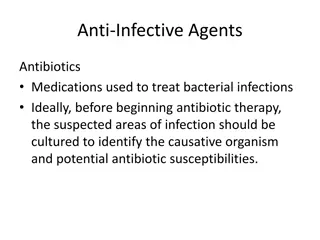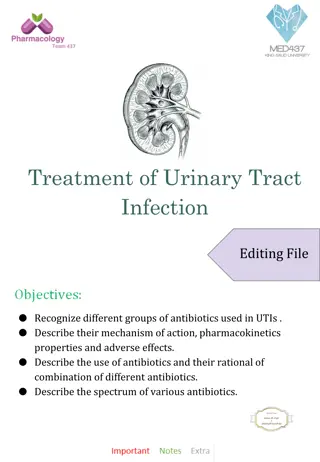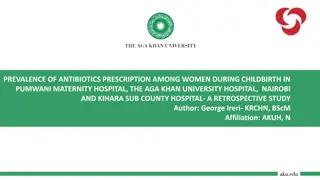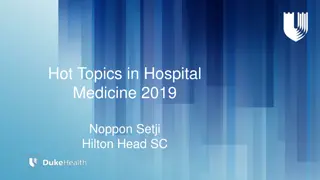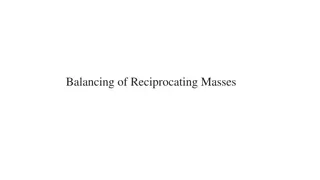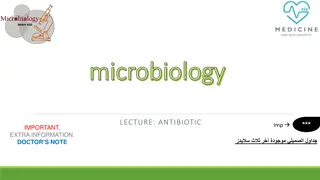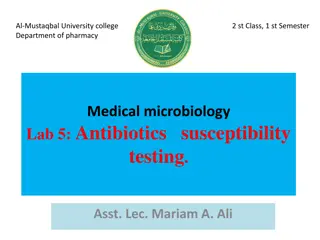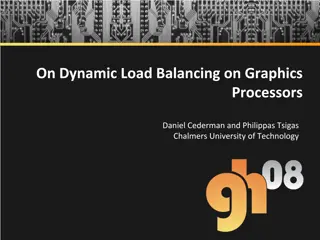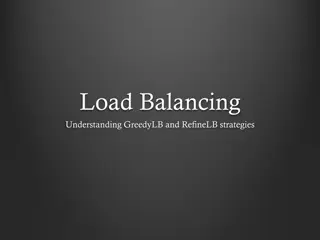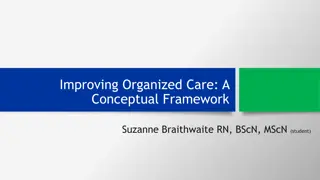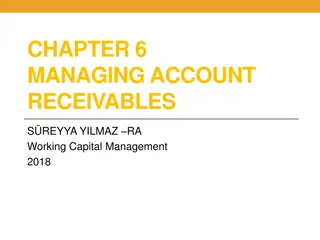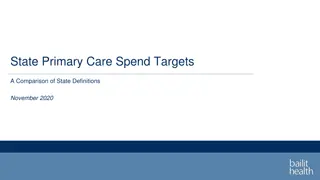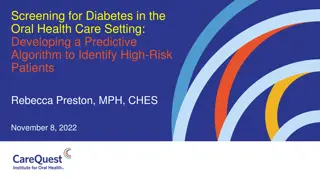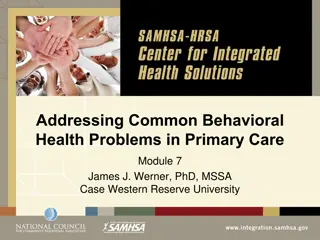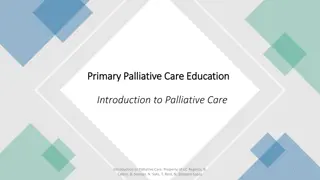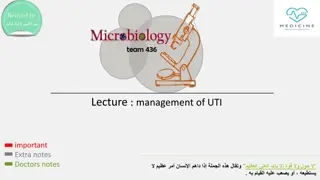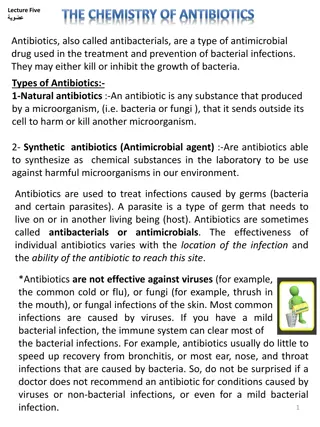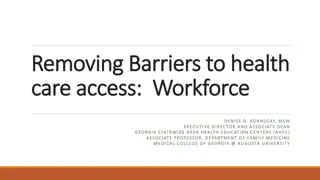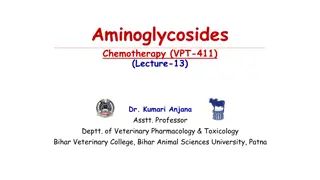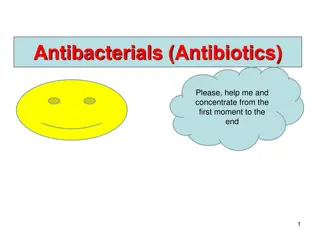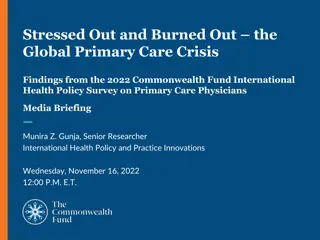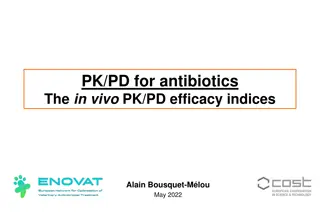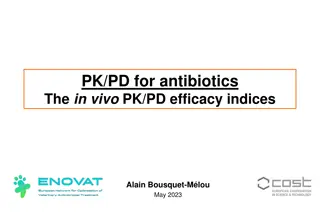Antibiotics in Primary Care: Balancing Benefits and Risks
Antibiotics play a crucial role in healthcare, but their overuse can lead to medicalization of illnesses and unnecessary prescriptions. Evidence suggests limited symptom relief from antibiotics in certain conditions. Delayed or back-up prescriptions are recommended to reduce unnecessary antibiotic use and reconsultations. The challenge lies in balancing the benefits of antibiotics with the risks of medicalizing illnesses and promoting antibiotic resistance.
Download Presentation

Please find below an Image/Link to download the presentation.
The content on the website is provided AS IS for your information and personal use only. It may not be sold, licensed, or shared on other websites without obtaining consent from the author. Download presentation by click this link. If you encounter any issues during the download, it is possible that the publisher has removed the file from their server.
E N D
Presentation Transcript
OUTLINE Brief intro/context Overall benefit from antibiotics & the natural history Medicalising illness? Delayed prescription: The trial evidence Systematic reviews of trials The cohort evidence Barriers? What next?
Overall do ABs help Symptoms? NOT MUCH! Evidence from RCTs & Systematic reviews Prior duration Duration after seeing doctor 3-5 days Total duration untreated 4 days Benefit from antibiotics NNT Otitis media 1-2 days 8-12 hrs 18 Sore throat 3 days 5 days 8 days 12-18 hrs 10-20 Sinusitis 5 days 7-10 days 12-15 days 24 hrs 13 Bronchitis 10 days 10-12 days 20-22 days 24 hrs 10-20 RULE of THUMB: week, 1 week, 2 weeks, 3 weeks
BUT It s Friday pm, you are running late A young man in his 20s comes in with his partner I had antibiotics last year for tonsillitis and I have got tonsillitis again doctor Would you say no to antibiotics? They attended because they believe antibiotics caused it to settle last time - i.e. Medicalised
HOW IMPORTANT IS MEDICALISING ILLNESS?
The potential problem with Medicalisation: THE ICEBERG Secondary care: 1:3300 General Practice 1:9 Pharmacy/NHS Direct Self Care Photo The_Circumference by kaplanmyrth https://www.flickr.com/photos/kaplanmyrth/2602542187/
THE PLACE OF DELAYED OR BACK-UP PRESCRIPTION?
AN OLD CHESTNUT! SORE THROAT TRIAL Open trial of prescribing strategies: - No offer of antibiotics - Immediate antibiotic prescription - Delayed prescription
MAIN RESULTS UK SORE THROAT TRIAL (N=715) P < 0.001 P < 0.001 100 80 60 % 40 20 0 % Better Satisfaction Belief Ab Future intent consult ANTIBIOTIC NO ANTIBIOTIC DELAYED
Even one antibiotic prescription is strongly medicalising Fuelling reconsultations, antibiotic use
OTITIS MEDIA Duration of Earache Cumulative percent Antibiotics Cumulative percent Delayed Advice package Last day of earache
LEVEL OF PAIN 1=NO PAIN 10=EXTREME 7 6 AB DELAYED Similar for distress Immediate antibiotics did reduce: night disturbance (-0.72 days) crying (-0.69 days) but children only using 2 spoons of Paracetamol per day 5 4 3 2 1 0 1 2 3 4 5 6 7 Days
LRTI PRESCRIBING STRATEGIES: DELAYED OR IMMEDIATE VS NONE 2 1.5 1 0.5 Days (Or diary Score) 0 -0.5 -1 -1.5 -2 Cough duration overall Cough Moderately bad duration Diary score for days 2-4
CONJUNCTIVITIS Figure 2 Re attendance within 2 weeks was less in the delayed: odds ratio 0.3 (0.1 to 1.0), immediate 0.7 (0.3 to 1.6).
HOW TO DO IT It s easy, but needs to be done properly (and will then reduce antibiotic use) Remember the 6 R s (most simply good practice!) 1. Reassurance 2. Reasons not to use antibiotics (side effects/allergy/AMR) 3. Relief: support Paracetamol (v limited use of NSAIDS) 4. Realistic natural history [1/2 week OM, 1 week throat, 2 wks. sinus), 3 wks. (chest)] 5. Reinforce key message: only use if getting worse or not even starting to settle in the expected average time 6. Rescue (safety netting)
HOW TO DO IT: II ? Re contact ? Post date ? Ask to collect ? Give it
WHICH WAY TO DELAY? PIPS TRIAL No Ab Re Patient -led LR chip Postdate Collect contact Sx 1.62 1.60 1.82 1.68 1.75 0.6 Severity Duration days mod bad Symps (median) Belief in Abs 3 4 4 4 4 0.3 71% 74% 73% 72% 66% 0.8 26% 37% 74% 37% 80% 33% 88% 39% 89% 0.3 0.8 Ab Use Vsatisfied 79% Symptom severity1o outcome:0 = no problem 6 as bad as it could be; alpha 0.71-0.79; srm 1.6
OVERALL Delayed or back-up prescription Is effective in reducing antibiotic use, if done properly Changes beliefs and behaviour effectively Overall symptom control in most patients similar to having an immediate antibiotic
WHAT ABOUT MY PARTICULAR PATIENT? TARGETING ANTIBIOTICS AND THE FLEXIBLE USE OF DELAYED PRESCRIPTION
MORE BENEFIT IN UNWELL INDIVIDUALS Otitis media: IPD meta-analysis (Lancet): <2y, pus, bilateral: NNTs 4-5 Benefit measured at days 3-7 when symptoms much milder UK trial: children with temperature (>37.5) or vomiting NNTs 3-5, for night disturbance, distress v. safe to wait 72 hours (24 h < 2 s) cohort 7000 children If more florid symptoms halve waiting time (36 h) Sinusitis: Individual Patient Data meta-analysis (Lancet): NNT 15 Patients with purulent discharge in pharynx NNT 8 Unwell patients still settle: ? shorten the wait if using back-up antibiotic prescription
SIMPLE STRATIFICATION FOR CHEST INFECTIONS: PRESCRIBING PNEUMONIA 2 History: breathless, no coryza 2 Chest signs: bronchial, crackles 2 Vital signs: pulse >100, temp. >37.8 0 = 1% Have consolidation on X-Ray 1-2 = 5% (most people we see ) 3 = 20% - consider immediate short delay
Does better diagnosis/targeting of delayed prescriptions lead to better outcome? Yes better symptom control and fewer antibiotics used
COCHRANE REVIEW OF DELAYED PRESCRIBING: Is no prescribing better? 6 studies Antibiotic use Satisfaction 93% 92% Immediate 28-30% 87% Delayed 4% 83% No Only 3 studies comparing no/delayed! Reconsultation and complications: underpowered NICE modelling: delayed prescribing most efficient DECARTE cohort
Does delayed prescribing prevent complications and reconsultations? DESCARTE sore throat cohort >13,000 patients!
RESULTS: Complications are uncommon Delayed Antibiotics No antibiotics Antibiotics Complications:total 73/4536 (1.6%) 75/5750(1.3%) 16/1664 (1.0%) 11/4,536 (0.2%) 30/5750 (0.5%) 4/1,664 (0.2%) Quinsy 23/4,536(0.5%) 10/5750(0.2%) 2/1,664 (0.1%) Sinusitis 30/4,536(0.7%) 26/5750 (0.5%) 10/1,664 (0.6%) Otitis media 10/4,536(0.2%) 9/5750 (0.2%) 0/1,664 (0.00%) Celluliltis/impetigo
DELAYED / BACK-UP PRESCRIBING COMPLICATIONS Delayed prescribing prevents complications as effectively as Immediate antibiotics No Immediate antibiotics Delayed antibiotics antibiotics Stratified Propensity score (Multiple imputation) 0.61 0.55 1.00 (0.40;0.94) (0.31,0.98) (Adjusted RRs All controlled for clustering)
DELAYED / BACK-UP PRESCRIBING COMPLICATIONS And lowers reconsultations more effectively than immediate antibiotics No Immediate antibiotics Delayed Antibiotics antibiotics Stratified Propensity score (Multiple imputation) 0.76 0.58 1.00 (0.68;0.86) (0.49,0.67) (Adjusted RRs All controlled for clustering)
DESCARTE SORE THROAT COHORT So complications are uncommon But if considering an antibiotic, consider back-up / delayed prescribing - Prevents complications, reduces re consultations - At least as effective as immediate antibiotics
COMMON CONCERNS 1? Patients will just go out and use it? Some will but low prescription rates if used with clear advice: 6 Rs It is giving mixed messages? No evidence of that if done clearly The message is you do not need antibiotics now and will get side effects if you do; Very occasionally people will need to use it and ONLY use this in the following situations ..
COMMON CONCERNS 2? It is not as effective as no offer of a prescription? Yes slightly higher rates of antibiotic use, but fine It will reduce number of patients who come back to see you by 1/3 Medico-legal consequences?: complications Similar reduction in complications compared with an immediate antibiotics Two very large cohorts to show that this the case It takes more time? Most of the 6 Rs you should be doing anyway The key difference is advice about when to consider cashing in
TARGET: PATIENT TREAT YOUR INFECTION LEAFLETS All sections can be personalised and added to by the GP Usually lasts section educates patients about when to consult Safety netting Back-up prescription Information about antibiotics & resistance READ CODES: Delayed:8CAk, Leaflet: 8CE www.rcgp.org.uk/TARGETantibiotics
WHAT NEXT? Try it: patients like it and you will get quicker It s easy, but do it properly (and will then reduce antibiotic use) Remember the 6rs (most of which are simply good practice!): Reassurance; Reasons not to use antibiotics Relief: paracetamol (v limited NSAIDs) Realistic natural history 1/2 week (OM), 1 wk. (throat), 2 wks. (sinus) 3 wks. (chest) Reinforce key message: ONLY use if getting worse or not even STARTING to settle in the expected average time Rescue (Safety netting) Aim to keep it for the 20-30% where you are unsure Audit to check how often you are using it It will reduce complications and save you time Fewer complications than no prescription; Fewer repeat consultations compared with no prescription or immediate


